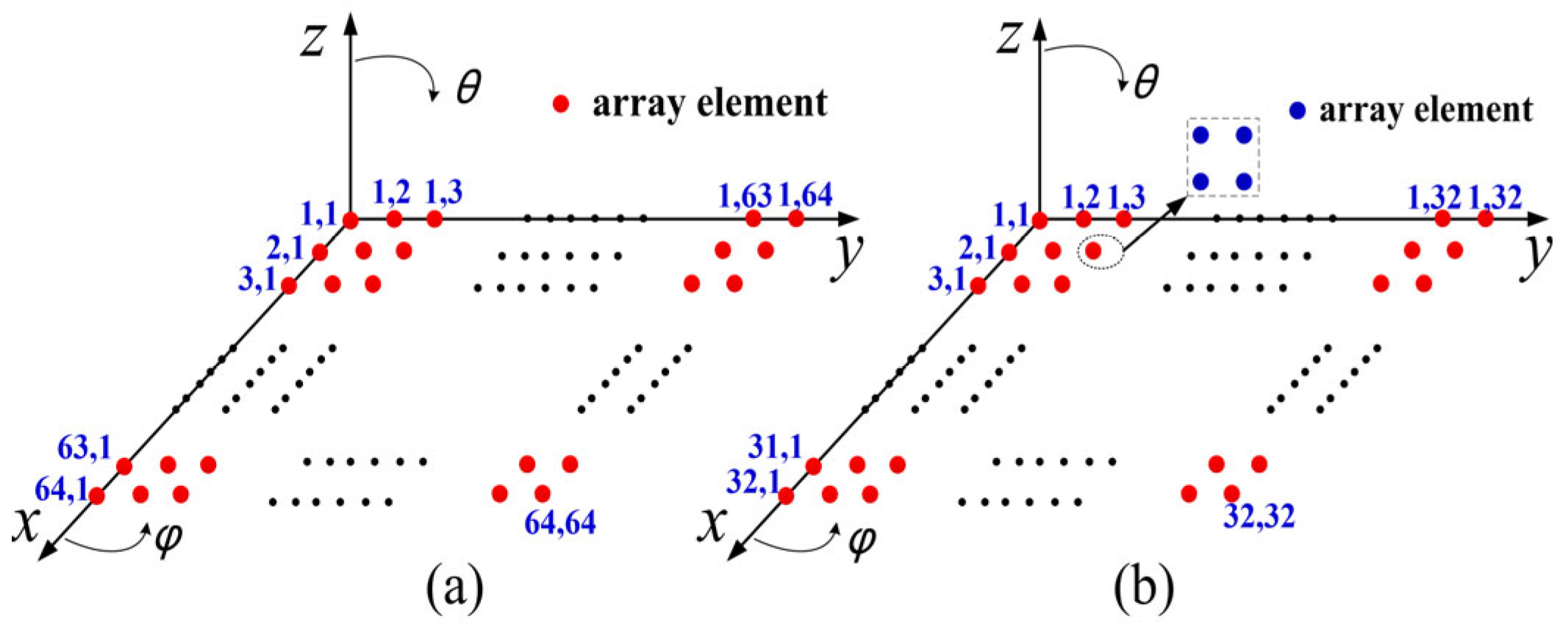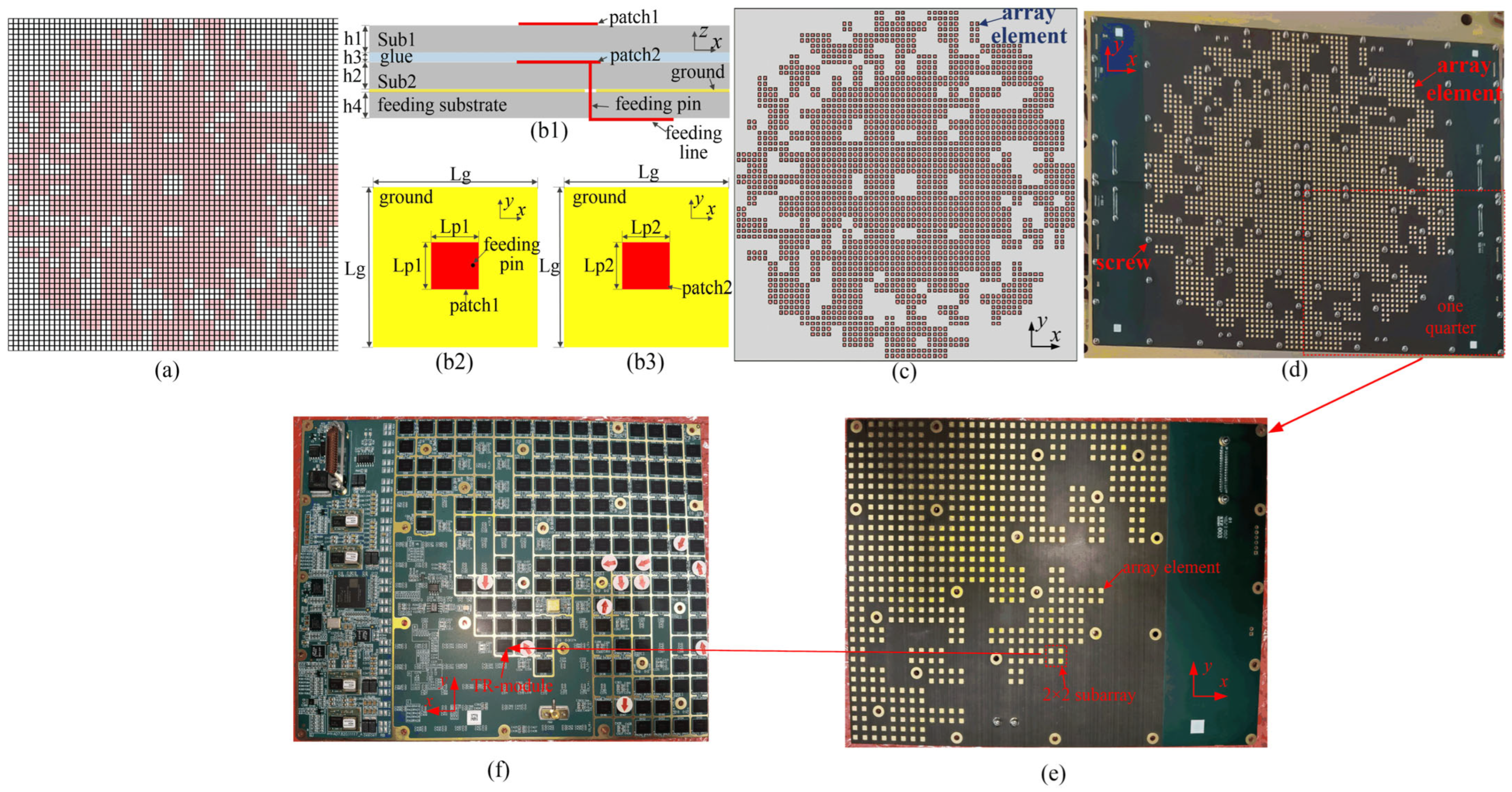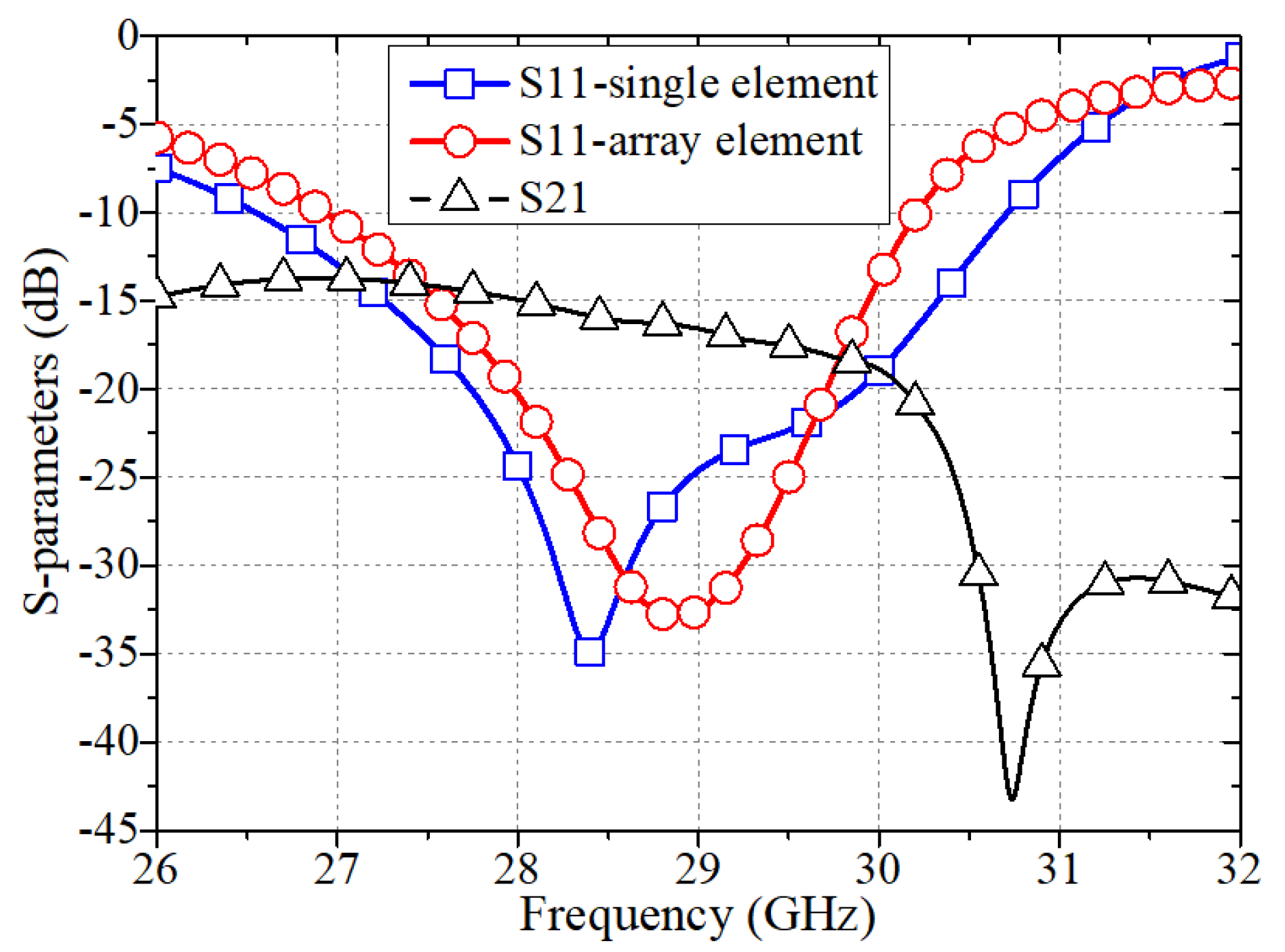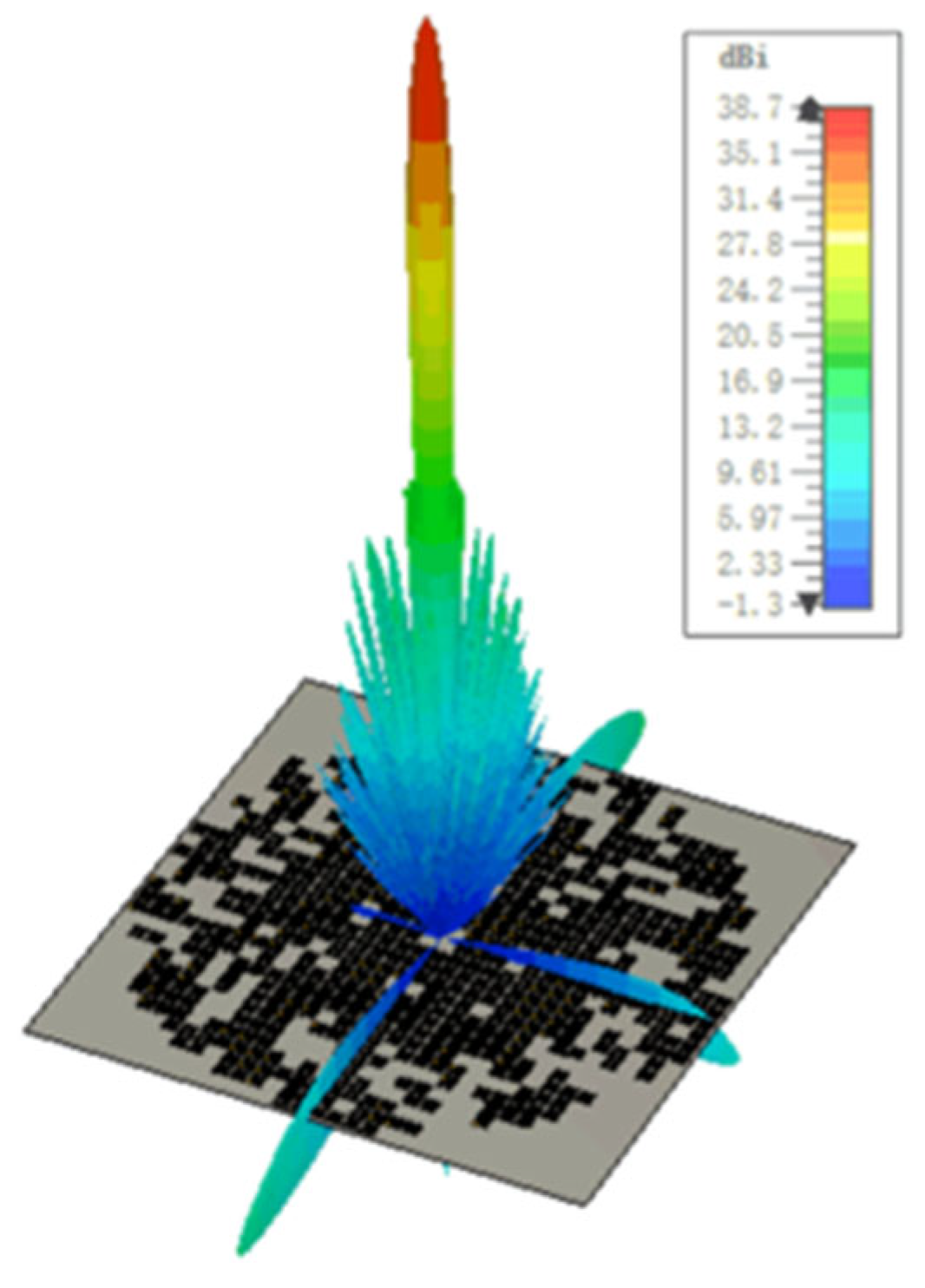Synthesis of the Large-Scaled 64 × 64 Thinned Array Using the Branch and Bound Technique with Convex Optimization for Satellite Communication
Abstract
1. Introduction
2. Formulation and Algorithm
- Problem Statement
- B.
- Mathematical Modeling
- C.
- Problem Solving
| Algorithm 1. The Algorithm of the Branch and Bound Technique with Convex Optimization |
| start ├── Convex Optimization Problem Setup │ └── Construct initial convex optimization problem ├── Convex Optimization Problem Solving │ └── Solve the initial convex optimization problem │ └── Obtain initial solution x * │ └── Update LB with the objective value of x * ├── Branching and Bounding │ └── while not stopping criterion │ ├── Select a branching variable │ ├── Branching │ │ └── for each branch │ │ └── Create a new convex optimization subproblem │ ├── Convex Optimization Subproblem Solving │ │ └── Solve the convex optimization subproblem │ │ └── Obtain solution x’ │ ├── Bounding │ │ └── if objective value of x’ is better than UB │ │ └── Update UB with the objective value of x’ │ │ └── Update global solution x * with x’ │ │ └── if lower bound of the subproblem is better than UB │ │ └── Recursively call ConvexBranchAndBound on the subproblem │ ├── Pruning │ │ └── Prune branches that are infeasible or have objective values worse than UB └── return x * end |
3. Results and Verification
- A.
- Array Structure and Array Element
- B.
- Performance of the Array Element
- C.
- Radiation Pattern of the Thinned Array
4. Conclusions
Author Contributions
Funding
Data Availability Statement
Conflicts of Interest
References
- ITU, Vision, Requirements and Evaluation Guidelines for Satellite Radio Interface(s) of IMT-2020. ITU-R Report M.2514-0. 2022. Available online: https://rfi.colem.co.uk/wp-content/uploads/ITU-R-IMT-2020-Satellite-5G-6G-Vision-Enhanced-Mobile-Broadband-Massive-Machine-Ultra-reliable-Low-Latency-Comms.pdf (accessed on 3 December 2024).
- 3GPP, Solutions for NR to Support Non-Terrestrial Networks (NTN). V16.2.0, Mar. 2023. 3rd Generation Partnership Project; Technical Specification Group Radio Access Network; NR; User Equipment (UE) Radio Transmission and Reception. Part 5: Satellite Access Radio Frequency (RF) and Performance Requirements (Release 18), Standard 3GPP TS 38.101-5 V18.4.0 (2023-12). Available online: https://www.etsi.org/deliver/etsi_ts/138100_138199/13810105/18.05.00_60/ts_13810105v180500p.pdf (accessed on 3 December 2024).
- 3rd Generation Partnership Project; Technical Specification Group Radio Access Network; Study on New Radio (NR) to Support NonTerrestrial Networks (Release 15), Standard 3GPP TR 38.811 V15.4.0 (2020-09).
- Hofmann, M. Satellite communication in the age of 5G. J. ICT Stand. 2020, 8, 247–252. [Google Scholar] [CrossRef]
- Lin, S.; An, J.; Gan, L.; Debbah, M.; Yuen, C. Stacked intelligent metasurface enabled LEO satellite communications relying on statistical CSI. IEEE Wirel. Commun. Lett. 2024, 13, 1295–1299. [Google Scholar] [CrossRef]
- Mailloux, R.J. Phased Array Antenna Handbook; Artech House: Norwood, MA, USA, 2005. [Google Scholar]
- Balanis, C.A. Antenna Theory and Analysis and Design; John Wiley &Sons: Hoboken, NJ, USA, 2005. [Google Scholar]
- Haupt, R.L. Adaptively thinned arrays. IEEE Trans Antennas Propag. 2015, 63, 1626–1632. [Google Scholar] [CrossRef]
- Rocca, P. Large array thinning by means of deterministic binary sequences. IEEE Antennas Wirel. Propag. Lett. 2011, 10, 334–337. [Google Scholar] [CrossRef]
- Gu, L.; Zhao, Y.-W.; Zhang, Z.-P.; Wu, L.-F.; Cai, Q.-M.; Hu, J. Linear array thinning using probability density tapering approach. IEEE Antennas Wirel. Propag. Lett. 2019, 18, 1936–1940. [Google Scholar] [CrossRef]
- Wang, X.-K.; Jiao, Y.-C.; Tan, Y.-Y. Synthesis of large thinned planar arrays using a modified iterative Fourier technique. IEEE Trans Antennas Propag. 2014, 62, 1564–1571. [Google Scholar] [CrossRef]
- Liu, Y.; Zheng, J.; Li, M.; Luo, Q.; Rui, Y.; Guo, Y.J. Synthesizing beam-scannable thinned massive antenna array utilizing modified iterative FFT for millimeter-wave communication. IEEE Antennas Wirel. Propag. Lett. 2020, 19, 1983–1987. [Google Scholar] [CrossRef]
- Zhang, J.; Mao, X.; Zhang, M.; Hirokawa, J.; Liu, Q.H. Synthesis of thinned planar arrays based on precoded subarray structures. IEEE Antennas Wirel. Propag. Lett. 2023, 22, 44–48. [Google Scholar] [CrossRef]
- Li, X.; Li, X.; Zhou, Z.; Zhang, C. Design and application of sparse array algorithm for Ka-band large-scale phased array. Telecommun. Eng. 2023, 63, 1524–1530. [Google Scholar]
- Tian, X.; Wang, B.; Tao, K.; Li, K. An improved synthesis of sparse planar arrays using density-weighted method and chaos sparrow search algorithm. IEEE Trans. Antennas Propag. 2023, 71, 4339–4349. [Google Scholar] [CrossRef]
- Goudos, S. Antenna design using binary differential evolution: Application to discrete-valued design problems. IEEE Antennas Propag. Mag. 2017, 59, 74–93. [Google Scholar] [CrossRef]
- Jiang, H.; Gong, Y.; Zhang, J.; Dun, S. Irregular modular subarrayed phased array tiling by algorithm X and differential evolution algorithm. IEEE Antennas Wirel. Propag. Lett. 2023, 22, 1532–1536. [Google Scholar] [CrossRef]
- Goudos, S.K.; Moysiadou, V.; Samaras, T.; Siakavara, K.; Sahalos, J.N. Application of a comprehensive learning particle swarm optimizer to unequally spaced linear array synthesis with sidelobe level suppression and null control. IEEE Antennas Wirel. Propag. Lett. 2010, 9, 125–129. [Google Scholar] [CrossRef]
- Zhang, F.; Yang, X.; Huang, Q.; Tao, J. The optimization of uniform concentric ring array using improved simulated annealing algorithm. In Proceedings of the International Conference on Artificial Intelligence and Advanced Manufacturing (AIAM), Dublin, Ireland, 16–18 October 2019. [Google Scholar]
- Li, S.; Wang, Y.; Xu, F. One-bit coding reconfigurable array for two-dimensional wide-angle scanning. IEEE Trans. Antennas Propag. 2023, 71, 2421–2432. [Google Scholar] [CrossRef]
- Liu, G.; Zhu, H.; Wang, K.; Qiu, Y.; Mou, J.; Zheng, P.; Wei, G. Low-Sidelobe Pattern Synthesis for Sparse Conformal Arrays Based on Multiagent Genetic Algorithm. In Proceedings of the IEEE International Symposium on Antennas and Propagation and USNC-URSI Radio Science Meeting (AP-S/URSI), Denver, CO, USA, 10–15 July 2022. [Google Scholar]
- Ha, B.V.; Mussetta, M.; Pirinoli, P.; Zich, R.E. Modified compact genetic algorithm for thinned array synthesis. IEEE Antennas Wirel. Propag. Lett. 2016, 15, 1105–1108. [Google Scholar] [CrossRef]
- Shan, T.; Pan, X.; Li, M.; Xu, S.; Yan, F. Coding programmable metasurfaces based on deep learning techniques. IEEE J. Emerg. Sel. Top. Circuits Syst. 2020, 10, 114–125. [Google Scholar] [CrossRef]
- Hong, Y.; Shao, W.; Lv, Y.-H.; Wang, B.-Z.; Peng, L.; Jiang, B. Knowledge-based neural network for thinned array modeling with active element patterns. IEEE Trans. Antennas Propag. 2022, 70, 11229–11234. [Google Scholar] [CrossRef]








Disclaimer/Publisher’s Note: The statements, opinions and data contained in all publications are solely those of the individual author(s) and contributor(s) and not of MDPI and/or the editor(s). MDPI and/or the editor(s) disclaim responsibility for any injury to people or property resulting from any ideas, methods, instructions or products referred to in the content. |
© 2024 by the authors. Licensee MDPI, Basel, Switzerland. This article is an open access article distributed under the terms and conditions of the Creative Commons Attribution (CC BY) license (https://creativecommons.org/licenses/by/4.0/).
Share and Cite
Li, X.; Wang, Y.; Zhang, C. Synthesis of the Large-Scaled 64 × 64 Thinned Array Using the Branch and Bound Technique with Convex Optimization for Satellite Communication. Electronics 2025, 14, 23. https://doi.org/10.3390/electronics14010023
Li X, Wang Y, Zhang C. Synthesis of the Large-Scaled 64 × 64 Thinned Array Using the Branch and Bound Technique with Convex Optimization for Satellite Communication. Electronics. 2025; 14(1):23. https://doi.org/10.3390/electronics14010023
Chicago/Turabian StyleLi, Xuelian, Yan Wang, and Chuansong Zhang. 2025. "Synthesis of the Large-Scaled 64 × 64 Thinned Array Using the Branch and Bound Technique with Convex Optimization for Satellite Communication" Electronics 14, no. 1: 23. https://doi.org/10.3390/electronics14010023
APA StyleLi, X., Wang, Y., & Zhang, C. (2025). Synthesis of the Large-Scaled 64 × 64 Thinned Array Using the Branch and Bound Technique with Convex Optimization for Satellite Communication. Electronics, 14(1), 23. https://doi.org/10.3390/electronics14010023






